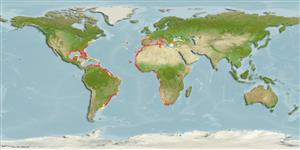Actinopterygii (ray-finned fishes) >
Clupeiformes (Herrings) >
Clupeidae (Herrings, shads, sardines, menhadens) > Dorosomatinae
Etymology: Sardinella: Latin and Greek, sarda = sardine; name related to the island of Sardinia; diminutive (Ref. 45335). More on author: Valenciennes.
Environment / Climate / Range
Ecology
Marine; brackish; reef-associated; oceanodromous (Ref. 51243); depth range 0 - 350 m (Ref. 5286). Subtropical; 24°C - ? (Ref. 54867), preferred 24°C (Ref. 107945); 47°N - 40°S, 98°W - 43°E (Ref. 54867)
Atlantic Ocean: West African coast from Gibraltar southward to Saldanha Bay in South Africa (Ref. 188, 81269, 81631); also in Mediterranean Sea (Ref. 188, 81631) and Black Sea (Ref. 188). In western Atlantic Ocean from Cape Cod in USA to Argentina (Ref. 188), including Bahamas, Antilles, Gulf of Mexico and the Caribbean coast (Ref. 26938).
Length at first maturity / Size / Weight / Age
Maturity: Lm 14.4, range 14 - 21.5 cm
Max length : 30.0 cm TL male/unsexed; (Ref. 188); common length : 25.0 cm SL male/unsexed; (Ref. 188); max. published weight: 229.00 g (Ref. 5217); max. reported age: 7 years (Ref. 839)
Dorsal
spines
(total): 0;
Dorsal
soft rays
(total): 13-21;
Anal
spines: 0;
Anal
soft rays: 12 - 23. Diagnosis: Body elongate, usually subcylindrical, but sometimes a little compressed; belly rather rounded, but scutes apparent (Ref. 188, 81269). Lower gillrakers fine and numerous, more than 80; anterior gillrakers on lower limbs of second and third gill arches lying more or less flat (Ref. 188). The pelvic finray count of 1 unbranched and 8 branched rays distinguishes Sardinella aurita from all other species of Sardinella, Harengula, Opisthonema, Herklotsichthys and Amblygaster that occur with it (Ref. 188). It resembles Clupea but it has two fleshy outgrowths along outer margin of gill opening and numerous fine fronto-parietal striae on top of head (Ref. 188). Flanks silvery, with a faint golden midlateral line, preceded by a faint golden spot behind gill opening; a distinct black spot at hind border of gill cover (Ref. 188, 3259).
Schools in coastal waters from inshore to edge of shelf. Prefers clear saline water with a minimum temperature below 24°C. Juveniles tend to stay in nursery areas, but on maturity rejoin adult stocks offshore. Strongly migratory, often rising to surface at night and dispersing. Feeds mainly on zooplankton, especially copepods. Juveniles take phytoplankton (Ref. 27121). Breeds perhaps throughout the year, but with distinct peaks. In some areas there are two main spawning periods. Marketed fresh or canned (Ref. 188). Trematode found in intestinal tract (Ref. 37032).
The breeding pattern is extremely complex, with two principal spawning periods in some areas (linked with upwelling regimes off west Africa).
Whitehead, P.J.P., 1985. FAO Species Catalogue. Vol. 7. Clupeoid fishes of the world (suborder Clupeioidei). An annotated and illustrated catalogue of the herrings, sardines, pilchards, sprats, shads, anchovies and wolf-herrings. FAO Fish. Synop. 125(7/1):1-303. Rome: FAO. (Ref. 188)
IUCN Red List Status (Ref. 115185)
CITES (Ref. 94142)
Not Evaluated
Threat to humans
Harmless
Human uses
Fisheries: highly commercial; bait: usually
Tools
Special reports
Download XML
Internet sources
